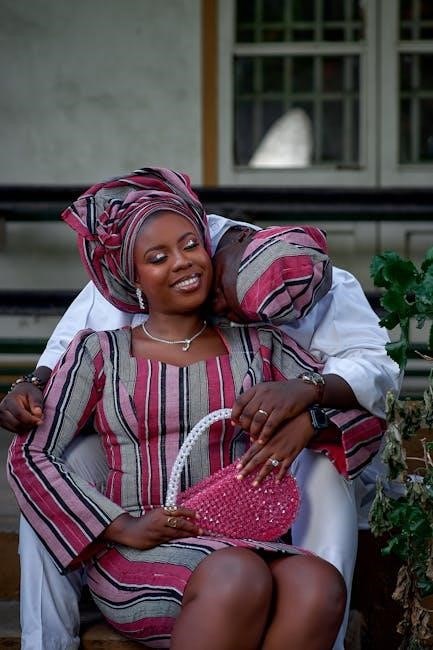A well-fitted dress shirt enhances both comfort and confidence. Understanding sizing ensures a tailored look, with key measurements like neck, chest, and sleeve length guiding the perfect fit.
Why Proper Sizing Matters
Proper sizing is crucial for both comfort and confidence. A well-fitted shirt ensures optimal mobility and a polished appearance, making it essential for professional and formal settings. Ill-fitting shirts can restrict movement or appear unflattering, while the right size enhances your physique. Proper sizing also impacts functionality, such as how buttons and cuffs align. Whether you’re dressing for a job interview or a special occasion, accurate measurements guarantee a shirt that complements your body type and personal style, ensuring you feel your best.
Understanding Shirt Measurements
Shirt measurements are based on key dimensions to ensure a perfect fit. These include neck circumference, chest width, sleeve length, waist, and shirt length. Accurate measurements help determine your size and style preferences. Measuring techniques require a flexible tape measure, ensuring comfort and precision. Properly understanding these measurements allows you to select a shirt that complements your body type, providing both comfort and a tailored appearance. Regular measurement updates are recommended to maintain the best fit over time.

Key Measurements for Men’s Dress Shirts
Key measurements include neck circumference, chest width, sleeve length, waist, and shirt length, ensuring a tailored fit and comfort for various body types and styles.
Neck Measurement
The neck measurement is a critical factor in determining shirt size. It is taken by wrapping a measuring tape around the base of the neck, where the collar sits. The tape should be snug but not too tight, ensuring comfort. Round the measurement up to the nearest half-inch to find your collar size. This measurement directly impacts the fit of the collar and overall comfort of the shirt. Accurate neck measurement ensures the shirt sits properly on the shoulders and allows for a full range of motion. Proper fit enhances both appearance and comfort, making it essential for a tailored look.
Chest Measurement
The chest measurement is crucial for determining shirt size, ensuring comfort and a tailored fit. To measure accurately, place the tape around the fullest part of the chest, keeping it level and parallel to the floor. The tape should be snug but not tight, typically just under the armpits. For the most accurate measurement, it’s best to measure without clothing. Double the chest measurement to get the full circumference, which helps in selecting the appropriate shirt size. Consulting a brand-specific size chart is recommended, as sizing can vary between brands. Accurate chest measurement, combined with other key measurements like neck and sleeve length, ensures a comfortable and flattering fit.
Sleeve Length Measurement
Sleeve length is measured from the center back of the neck, over the shoulder, and down to the wrist. Place the tape measure at the base of the neck, ensuring it stays straight and parallel to the floor. The measurement should end where the cuff meets the wrist bone. Accurate sleeve length is essential for comfort and style, ensuring the cuffs fit snugly around the wrist without being too tight or loose. Proper sleeve length complements the overall fit, making it a critical measurement for a tailored look. Different sleeve lengths suit various body types and preferences, so measuring carefully ensures the best fit.
Waist Measurement
Waist measurement is taken around the narrowest part of your torso, typically one inch above your belly button. Stand upright and relax your stomach to ensure accuracy. The tape measure should be level and not too tight or loose. This measurement helps determine how the shirt will fit around your midsection, ensuring it isn’t too baggy or restrictive. For dress shirts, the waist measurement is crucial for achieving a balanced fit, especially in tailored or slim-fit styles. Accurate waist sizing ensures comfort and a polished appearance.
Shirt Length Measurement
Shirt length is measured from the base of the collar to the hem at the back. Stand straight and measure along the spine to ensure accuracy. Proper shirt length ensures the shirt stays tucked in and maintains a neat appearance. For dress shirts, the length should cover the belt line but not extend past the hips. Accurate measurement ensures comfort and prevents the shirt from being too short or overly long, offering a balanced fit for all body types and styles.
How to Measure Yourself Accurately
To measure yourself accurately for a men’s dress shirt:
Neck Measurement: Place the tape measure around the base of your neck, where the collar sits. Ensure it’s snug but not too tight.
Chest Measurement: Measure around the widest part of your chest, just under the armpits. Take a deep breath and exhale to get an accurate reading.
Sleeve Length: Measure from the center back of the neck, over the shoulder, and down to the wrist. Follow the natural curve of the arm.
Waist Measurement: Measure around the narrowest part of your torso, just above the hips. The fit should be snug but comfortable.
Shirt Length: Measure from the base of the collar to the hem at the back. Ensure it covers the belt line without being excessively long.
Additional Tips:
⸺ Stand straight and avoid slouching for accurate measurements.
⸺ Consider the type of fit (slim, regular, tailored) and fabric stretch.
⸺ Remeasure periodically due to weight changes.
― Practice makes perfect—consistent measurements lead to a perfect fit.
By following these steps and tips, you’ll be able to determine your measurements accurately and find shirts that fit you well.
Measuring the Neck Circumference
To measure the neck circumference accurately, place a flexible tape measure around the base of your neck, where the collar of your dress shirt would sit. The tape should be snug but not too tight, allowing room for one finger to slide underneath comfortably. Stand straight and avoid slouching to ensure an accurate reading. Round the measurement to the nearest half-inch to determine your collar size. This measurement is crucial for achieving a comfortable and tailored fit in the neck area of your dress shirt. Regular remeasurement is recommended to account for any body changes.
Measuring the Chest Circumference
To measure the chest circumference, wrap a flexible tape measure around the widest part of your chest, keeping the tape level and parallel to the floor. The tape should be snug but not tight, with your arms relaxed at your sides. The measurement is taken just under the armpits, across the shoulder blades, and around the fullest part of the chest. Stand straight and breathe normally to ensure accuracy. Double the chest measurement to determine the full circumference, which is essential for selecting the correct shirt size.
Measuring Sleeve Length
To measure sleeve length, stand straight with arms relaxed at your sides. Place the tape measure at the base of your neck, where the collar sits, and extend it down the arm’s natural curve to the wrist. Keep the tape smooth and level, avoiding twists. The measurement ends where the sleeve cuff would typically rest, ensuring comfort and proper fit. This ensures the shirt’s sleeves are neither too short nor too long, complementing your posture and movement.
Measuring Waist and Shirt Length
To measure your waist, wrap the tape measure around the narrowest part of your torso, typically just above the hipbone. Keep the tape level and snug but not tight. For shirt length, measure from the base of your neck at the back down to your desired hem length, ensuring the shirt falls comfortably below the hips. This ensures the shirt isn’t too short or too long, providing a balanced and polished appearance while allowing ease of movement.

Understanding Shirt Sizes
Shirt sizes are determined by measurements like neck, chest, and sleeve length. Sizes vary by brand, with options like Slim Fit, Regular, and Tailored to suit different body types.
Standard Shirt Sizes
Standard shirt sizes are based on body measurements, typically categorized as Small, Medium, Large, and Extra-Large. These sizes correlate to specific neck, chest, and sleeve lengths. For example, a Medium shirt usually fits a 15-15.5 inch neck, 38-40 inch chest, and 32-33 inch sleeve length. Sizes vary slightly by brand but generally follow these guidelines. Understanding your measurements helps match to the closest standard size. Always refer to a size chart for accuracy, as fit preferences may differ, ensuring comfort and style.
Slim Fit vs. Regular Fit
Slim Fit shirts are tailored closer to the body, offering a modern, streamlined appearance. They feature narrower chests, shorter lengths, and slimmer sleeves, ideal for those seeking a fashionable, contemporary look. Regular Fit shirts provide a classic, comfortable cut with more room through the chest and sleeves, suitable for a broader range of body types and everyday wear. Slim Fit suits younger men or those preferring a trendy style, while Regular Fit appeals to those valuing ease and versatility.
Tailored Fit Explained
A Tailored Fit shirt combines elements of both Slim and Regular fits, offering a balanced, polished appearance. It is designed to skim the body without being overly tight, providing a structured yet comfortable silhouette. Tailored Fit shirts typically feature a slightly tapered chest, proportionate sleeves, and a moderate shirt length. This style is ideal for men seeking a classic, professional look that flatters most body types. It is less restrictive than Slim Fit but more refined than Regular Fit, making it versatile for formal or business-casual occasions.
Factors That Affect Fit
Accurate measurements, fabric stretch, and seasonal variations influence how a shirt fits; Proper sizing ensures comfort and style, while incorrect measurements can lead to an ill-fitting garment.
Body Type and Shirt Fit
Understanding your body type is crucial for selecting a shirt that fits well. Slim-fit shirts suit lean physiques, while muscular builds may prefer regular or tailored fits. Average body types can opt for classic styles, but larger frames benefit from relaxed fits. Tall individuals should ensure sleeve and shirt lengths are proportionate. Measuring accurately helps match your physique to the ideal shirt style, ensuring comfort and a polished appearance. Proper fit enhances confidence and complements your overall look, making body type a key factor in shirt selection.
Fabric and Stretch
Fabric choice significantly impacts shirt fit and comfort. Stretch fabrics, like those with spandex or elastane, offer flexibility, making them ideal for active individuals or those seeking a snug fit. Non-stretch fabrics, such as pure cotton, provide a more structured appearance. The weave and weight of the fabric also influence how the shirt drapes on the body. Considering fabric stretch ensures the shirt moves with you while maintaining its shape, enhancing both comfort and style. This balance is essential for achieving a flattering and functional fit.
Seasonal Differences in Fit
Seasonal variations in fabric weight and style can influence how a dress shirt fits and feels. Lighter fabrics, like linen or cotton, are often used in summer for breathability, while heavier fabrics such as flannel dominate winter designs. Summer shirts may feature a looser fit for comfort, whereas winter styles might be slightly tailored to layer seamlessly under outerwear. Understanding these seasonal differences helps in selecting shirts that not only fit well but also align with the practical needs of each time of year, ensuring optimal comfort and style.

Common Style Elements
From collar types to cuff styles, common elements in men’s dress shirts influence both aesthetics and functionality, ensuring a polished look that complements individual preferences and sizing needs.
Collar Types and Their Impact on Fit
Collar types significantly influence a shirt’s fit and styling. A point collar is the most common, suitable for most face shapes and neck sizes. A spread collar offers a modern look, ideal for wider faces or those wanting a sleek appearance. The button-down collar provides a casual vibe, while a wing-tip collar is reserved for formal events. The right collar style can enhance facial features and create balance, ensuring a polished look that complements the shirt’s overall fit and design.
Cuff Styles and Sleeve Fit
Cuff styles play a crucial role in the overall fit and aesthetic of a dress shirt. Barrel cuffs are the most common, featuring a single button closure for a classic look. French cuffs are more formal, requiring cufflinks and offering a sleek, sophisticated appearance. The choice between a button-down and spread collar significantly impacts a shirt’s style and fit. A button-down collar features buttons at the tips to secure the collar, creating a casual yet polished look. It works well for slimmer faces and adds a subtle detail to the shirt. In contrast, a spread collar is wider and more formal, ideal for wearing with ties. The spread collar flatters broader face shapes and offers versatility in both professional and social settings. Both styles enhance fit when paired with appropriate attire. To determine your dress shirt size, start by measuring your neck, chest, and sleeve length. Use a tape measure to find your neck circumference at the base where the collar sits. For chest measurement, wrap the tape around the fullest part of your chest, keeping it level and snug. Sleeve length is measured from the center back of your neck, over the shoulder, and down to the wrist. Compare these measurements to a brand’s size chart, considering fit styles like Slim Fit, Regular Fit, or Tailored Fit. Factors like fabric stretch and collar style can also impact fit, so choose options that complement your body type and preferences. For accuracy, consider having someone assist with measurements or trying on shirts to ensure the best fit. Measure your neck circumference at the base where the collar sits. 2. Measure your chest around the fullest part, keeping the tape level. 3. Measure sleeve length from the center back of your neck, over the shoulder, to the wrist. 4. Compare these measurements to a size chart, noting fit styles like Slim Fit, Regular Fit, or Tailored Fit. 5. Consider fabric stretch and collar style for comfort. 6. Try shirts on if possible, or use brand-specific tools for accuracy. This ensures a tailored fit that complements your physique and enhances your appearance. Using a size chart is essential for selecting the right fit. Compare your neck, chest, and sleeve measurements to the chart. Note the fit style—Slim Fit, Regular, or Tailored. Fabric stretch and seasonal differences may affect sizing. Double-check measurements for accuracy. Some charts include numeric sizes (S-XL) or alphanumeric (15-17). Brand-specific charts may vary, so refer to the brand’s guide; This method ensures a perfect fit without trial and error, saving time and effort when shopping online or in-store. Comparing sizes across brands requires careful attention to detail, as sizing standards vary. Always refer to each brand’s specific size chart, as measurements for neck, chest, and sleeve length may differ slightly. Note the fit style (Slim, Regular, or Tailored) offered by the brand. Use your own measurements as a baseline and cross-reference them with the brand’s chart. If shopping internationally, consider size conversion guides. Reading customer reviews can also provide insights into how a brand’s sizes run. This ensures a more accurate fit when purchasing from different brands. Mens dress shirt sizing varies by region, brand, and era, with differences in measurements, fit styles, and fabric stretch affecting overall size accuracy and comfort. European and American sizing differ significantly in men’s dress shirts. European sizes often run smaller, with a greater emphasis on tailored fits, while American sizes tend to be more generous. European shirts may have slimmer sleeves and a narrower chest, catering to a leaner physique. American sizes, however, accommodate broader shoulders and taller builds. These variations can lead to confusion, so comparing measurements to size charts is essential. Understanding these differences helps ensure the best fit, regardless of regional sizing standards. Asian and Western sizing for men’s dress shirts differ due to regional fit preferences and body type averages. Asian sizes often cater to shorter sleeve lengths and narrower chest measurements, reflecting a generally more compact physique. Western sizes, particularly American ones, tend to offer broader chest measurements and longer sleeves, accommodating taller and larger builds. Fit preferences also vary, with Asian styles frequently emphasizing slimmer cuts, while Western shirts may offer a looser, more relaxed fit. These differences highlight the importance of consulting size charts for accurate sizing across regions. Vintage and modern sizing differ significantly in men’s dress shirts. Vintage shirts often fit tighter, with slimmer cuts and shorter sleeves, reflecting earlier fashion norms. Modern sizing tends to be more generous, offering relaxed fits and longer sleeves to accommodate contemporary body types. Vintage shirts may also have smaller chest measurements and narrower shoulders compared to today’s standards. Additionally, modern sizing often includes stretch fabrics and more standardized measurements, whereas vintage sizing can vary widely between brands and eras, making size comparisons challenging. Ensure accurate measurements, consider body type, and choose fabrics that complement your physique. Try shirts on if possible and avoid common sizing mistakes for optimal comfort. Achieving comfort starts with accurate measurements, ensuring the shirt isn’t too tight or restrictive. Opt for breathable fabrics like cotton to maintain airflow and prevent discomfort. Avoid oversized shirts that may look sloppy, and ensure the collar sits smoothly without digging into the neck. Sleeves should allow free arm movement, and the shirt length should be proportionate to your torso. Pay attention to stretch in fabrics for added flexibility, and consider seasonal variations in fit to adapt to different conditions. Proper fit enhances both comfort and style seamlessly. Different body types require tailored approaches for the best fit. Slim builds benefit from fitted shirts to avoid a boxy look, while athletic physiques may need slightly more room in the chest and shoulders. Larger frames should opt for shirts with a bit more chest and waist room for comfort. Ensure the collar fits snugly without restricting movement, and sleeves align with the natural length of your arms. By considering your body type, you can select a shirt that flatters your shape and ensures a polished appearance. Avoid relying solely on standard sizes, as they vary between brands. Not measuring regularly can lead to ill-fitting shirts. Ignoring fabric stretch and seasonal differences may result in discomfort. Ensure proper measurement techniques to avoid errors. Don’t overlook the importance of collar fit and sleeve alignment. Lastly, avoid assuming all brands use the same sizing standards—always check specific charts for accuracy. These mistakes can compromise both comfort and style, making it essential to be meticulous in your approach. Proper care ensures longevity and maintains fit. Wash inside out, avoid hot water, and dry flat to prevent shrinkage. Store shirts hung to keep them wrinkle-free. Washing can impact the fit of your dress shirt due to shrinkage or fabric relaxation. Hot water and aggressive detergents may cause fabrics to shrink, tightening the fit. Over-drying can also reduce elasticity, affecting comfort. To maintain the fit, wash shirts inside out in cold water and avoid bleach. Air-drying prevents shrinkage, while ironing restores shape. Regular washing in harsh conditions can stretch or misshape collars, altering the neckline fit. Proper care ensures the shirt retains its measurements and remains comfortable over time. Proper drying and ironing are crucial for maintaining your dress shirt’s fit and appearance. Air-dry shirts to prevent shrinkage, especially for cotton fabrics. Iron while slightly damp to restore shape and remove wrinkles. Use steam for stubborn creases but avoid high heat on delicate materials. Iron collars last to maintain their structure. Hang shirts immediately after ironing to prevent new wrinkles from forming. Regular steaming can also refresh fabrics without washing, ensuring a crisp look and fit over time. Proper storage preserves the fit and appearance of your dress shirts. Hang them on wide, padded hangers to maintain shape and prevent stretching. Avoid folding, but if necessary, use acid-free tissue paper to minimize wrinkles. Store in a cool, dry place away from direct sunlight. Use breathable fabric bags instead of plastic to prevent moisture buildup. Organize shirts by size or occasion for easy access. Regularly cleaning and storing shirts ensures they remain crisp and well-fitted, extending their lifespan and maintaining their quality over time. Utilize online size charts and measurement guides for accuracy. Brand-specific tools and video tutorials offer detailed guidance, ensuring the perfect fit for every body type and style. Online size charts provide detailed measurements for men’s dress shirts, ensuring accurate sizing. They often include interactive tools and guides to help determine your size based on body measurements; Many retailers offer brand-specific charts, catering to different fits like slim, regular, or tailored. These charts typically include neck, chest, sleeve length, and shirt length measurements. By inputting your measurements, you can find the perfect fit without guessing. Regularly updated, they reflect the latest sizing standards and styles, making them a reliable resource for shoppers. Always refer to the chart specific to the brand you’re purchasing from for the best results. Measurement guides and videos are invaluable resources for understanding how to accurately measure yourself for a dress shirt. These tools provide step-by-step instructions and visuals to ensure precise measurements. They often include detailed explanations of how to measure the neck, chest, sleeve length, and shirt length. Videos demonstrate the process in real-time, making it easier to understand proper technique. Many guides also cover how to interpret measurements and match them to size charts. By following these resources, you can avoid common mistakes and achieve a perfect fit tailored to your body type and style preferences. Brand-specific sizing tools are designed to help you find your perfect fit within a particular brand’s range. Many brands offer interactive size charts and measurement guides tailored to their unique cuts and styles. Some even provide virtual try-on features or fit predictors based on your measurements. These tools ensure accuracy and consistency, allowing you to shop confidently online or in-store. By using these resources, you can navigate the nuances of each brand’s sizing system and select a shirt that matches your body type and personal style seamlessly. A perfectly fitted dress shirt elevates confidence and style. By understanding measurements, sizes, and brands, you can make informed choices for a tailored, comfortable fit every time. Achieving the perfect fit in a men’s dress shirt is a balance of accurate measurements and understanding your body type. Always use a size chart and consider fabric stretch for comfort. Ensure the collar fits snugly, sleeves are proportional, and the shirt skims your torso without restriction. Avoid common mistakes like ignoring neck measurements or assuming sizes across brands. Experiment with styles, and don’t hesitate to seek tailor adjustments. Investing time in finding your ideal fit ensures confidence and a polished appearance in every occasion.Button-Down vs. Spread Collar

Determining Your Size
Step-by-Step Guide to Finding Your Size
Using a Size Chart
How to Compare Sizes Across Brands

Sizing Variations
European vs. American Sizing
Asian vs. Western Sizing
Vintage vs. Modern Sizing

Tips for a Perfect Fit
How to Ensure a Comfortable Fit
Adjusting for Body Type
Common Mistakes to Avoid

Caring for Your Dress Shirt
How Washing Affects Fit
Drying and Ironing Tips
Storing Dress Shirts Properly
Resources and Tools
Online Size Charts
Measurement Guides and Videos
Brand-Specific Sizing Tools
Final Thoughts on Achieving the Perfect Fit
